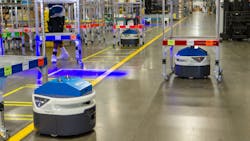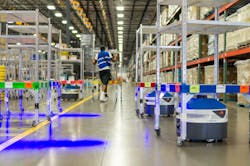Industry 4.0 Is Yet Unrealized, but AMRs Can Help
Throughout tech and business circles, “Industry 4.0” has become the buzzword of the day. Representing an interconnected future of hyper-productivity and innovation, Industry 4.0 is positioned as a powerful concept that’s already shaping investment decisions and company strategy. No matter how you personally feel about the narrative of Industry 4.0 as the future of manufacturing, some of its underlying principles—like automation—are worth examining for how they are beginning to shape our world.
Deloitte defines Industry 4.0 as a merging of the Internet of Things (IoT) and manufacturing techniques to create systems that “are not only interconnected, but communicate, analyze, and use the information to drive further intelligent action back in the physical world.” Across the industry, Autonomous Mobile Robots (AMRs)—which can be defined as smart, self-optimizing robots that don’t need human guidance—are being seen as a great example of this vision coming true. Today, AMRs are commonplace on factory floors and can be found integrated into all kinds of manufacturing processes, from food and life sciences to plastics and electronics. In fact, forecasts predict that the AMR industry will be worth almost $59 billion by 2026. If you are an Industry 4.0 believer, it would seem that we are on the brink of ushering in the next Industrial Revolution. But even non-believers can agree that automation will become even more of a driving factor in gaining efficiencies, and AMRs will be one of the foundations of this automation.
While I believe in their promise, the on-the-ground reality today is a lot more sobering: AMRs have made vast improvements for manufacturers and 3PLs, but if we want to transform the sector and unlock the true value of automation, we need to think differently about the potential of AMRs.
As they are currently used, AMRs are smart, safe, reliable tools for material delivery that are able to execute tasks without human supervision. This is not to be minimized because it frees up human workers from low-value work; saves them from physical stress; and thus, ensures their long-term health and tenure. But it’s important to remember that while they are implementing these manual tasks, AMRs are also capturing data about the facility as large IoT devices—a key component of Industry 4.0 technology. AMRs are essentially a collection of sensors on wheels that while moving material, collect an incredible amount of sensor data that can be used to increase the efficiencies of facilities in ways not previously possible. When harnessed through cloud-connected tools that can analyze and act on that information, sensor data collected from AMRs can provide critical insights to managers on overall warehouse operations, and improve their understanding of its resources and limitations. This ability is what we should be capitalizing on: we need to treat AMRs not just as robotic workhorses, but as smart, connected machines driving ongoing insights.
But how do we assess this evolution, and what benefits does it offer manufacturers? When evaluating an AMR in the upcoming decade, take the following considerations into account.
Put Connected Data to Work:
Despite the many technological advancements the manufacturing sector has made in recent years, efficiency has remained a problem—even as recently as 2018, the industry saw productivity and efficiency declines across streams. To fix this, AMRs need to deliver unparalleled data insights. A good example of this is how AMRs can help factories redesign their workflows by assessing congestion of people or equipment. Based on data on where and why it’s happening, a manager may decide to widen often-used aisles while narrowing others that are home to smaller items, leading to gains in productivity that would have otherwise remained beyond reach. Moreover, with a cloud-based model, all of this insightful data captured by AMRs can reside in unlimited storage and be leveraged by the most advanced Machine Learning tools, meaning that no insights are ever lost to the operations manager, and can be easily compared across multiple sites.
See Around Corners and Safeguard Production:
In a world where humans and robots
will be working together, safety is rightfully a top concern. This is where a data-focused AMR can help warehouse management be proactive and prevent accidents before they occur. Take forklift accidents as an example: they are one of the biggest safety concerns in a warehouse, leading to 85 deaths and nearly 35,000 injuries every year in the United States. More advanced AMR usage than what is common today can let managers know where near-misses are occurring so they can tweak workflows in advance. AMRs can also help managers stay compliant with the stringent warehouse safety protocols, notifying managers when access to fire doors or fire extinguishers are blocked. Lastly, AMRs can also serve as a “dashcam” for the facility, as they can “see” what’s going on and furnish critical information on issues like product damage or shrinkage.
Supporting Ever-Changing Output Needs:
Manufacturing facilities need to be
dynamic—not only may the type of product and the quantities needed vary from month to month, but workflows may need to be adapted for short periods due to emergencies or accidents. AMRs can help manufacturing sites be more nimble when, say, there is a spill from a leaking roof, by simply re-routing work paths out of the affected area. Also, when connected to the cloud, AMRs can be set up the same day they are received, and be maintained via a zero-touch, always-on approach: there is no need for managers to install or maintain software. Managers can also add or maintain any number of robots across any number of locations through a single interface, allowing them to test processes and make tweaks that maximize ROI over time. All these advantages lead to incredible savings of dollars and time: according to IDC, 70% of companies that deployed robotics realized double-digit improvements in KPIs like efficiency and speed.
So far, Industry 4.0 has led to mixed results—some of that vision has been realized thanks to the power of automation, while a large part of it remains a dream still. Current AMRs are a good first step towards converting that promise to reality—but they still exist mostly in the physical world, while the data that can help them elevate the smart warehouse is locked in the digital world. In 2020, let’s bridge the gap and encourage AMRs to inform the physical world with their digital insights. By raising the bar for what we expect out of AMRs, manufacturing enterprises can not only see impressive gains on ROI but also free up precious human time for increased job satisfaction and career advancement. A fitting welcome to the next Industrial Revolution, indeed.
About the Author
Melonee Wise
CEO, Fetch Robotics
From manufacturing to delivering a product to a shopper’s doorstep, the race for ever more efficiency is fierce. Melonee Wise’s autonomous, mobile robots make it easier to find, track, and move items in warehouses and factories. Understanding where there’s congestion, for instance, is powerful information for a warehouse manager. A mechanical-engineering PhD and founder of a previous robotics company, Wise has led San Jose, California-based Fetch Robotics since shortly after its founding in 2014.

